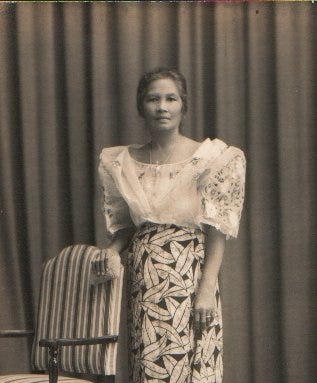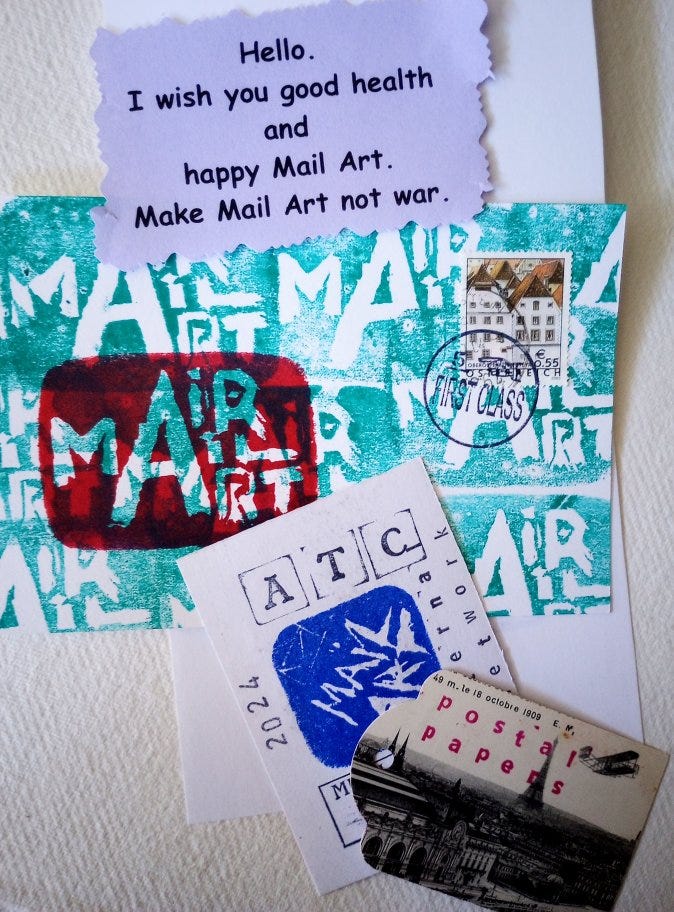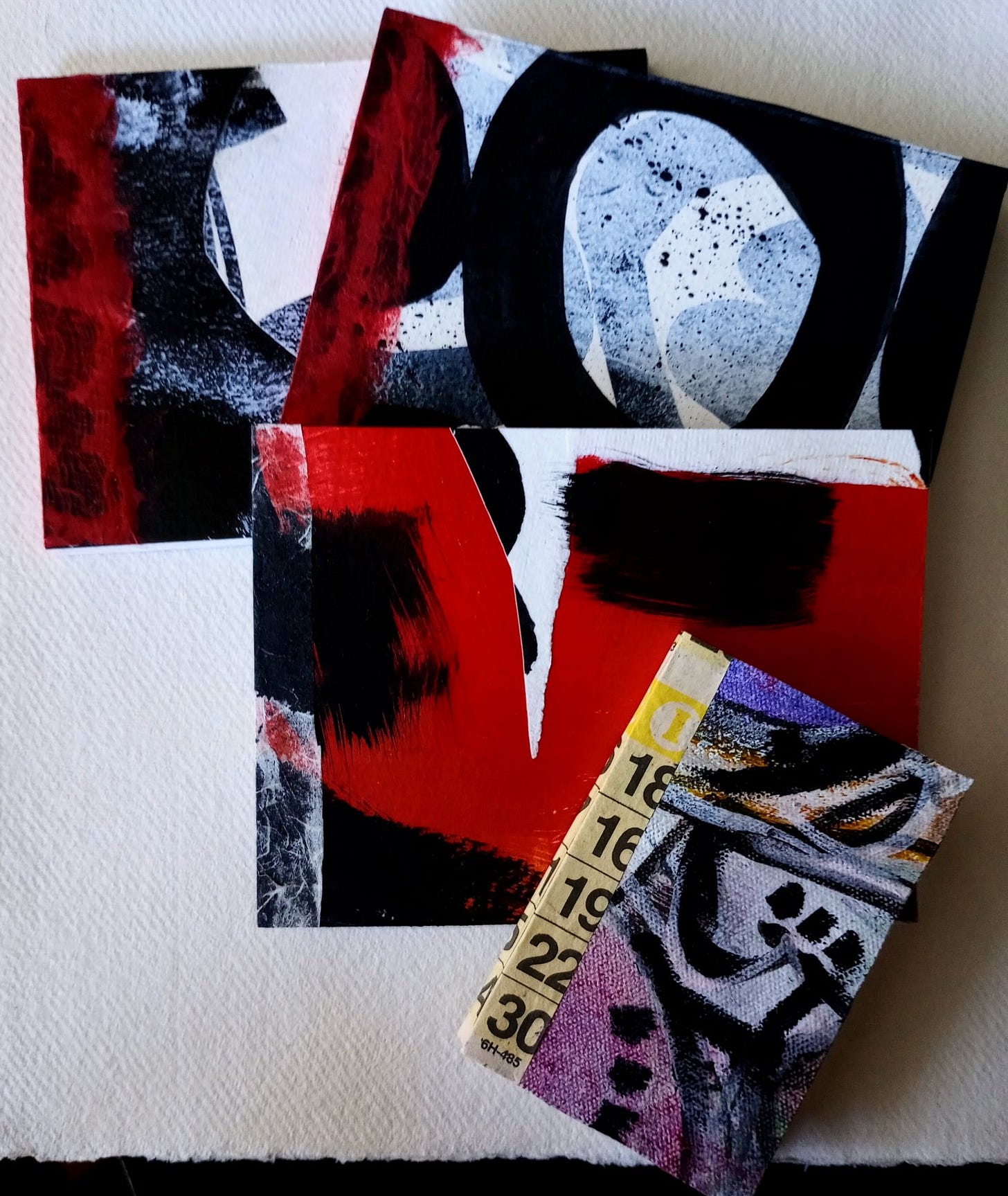Depth of Field
How does your understanding of the story change as you shift your focus to a wider view?
THEN & NOW
Today, All Saints Day (Nov. 1), I picked up a letter at random, and it was from my Aunt Dading (short for Leonarda) to my mom, telling her that their mother, my grandmother Matea, had traveled to her hometown in Zambales on All Saints Day. She stayed there for five days, probably visiting relatives.
I never met my grandmother. When I think of her, I call her “Lola (grandma) Matea.” But I recently learned from my older cousin Emma (Geronima Tomelden Carino) that Grandma was called “Papo Tiang” by my relatives who spoke Sambal. I had never heard that term from my mother. Knowing that one extra detail about my grandmother adds another dimension to a person about whom I know only a little, connecting her and myself across time and place to the wider family.
As an American-born Filipina (born in the 1950s), I grew up considering Spanish, English, and Tagalog as the primary languages of the Philippines—information that I got from my mom. Although the Philippines was colonized by the U.S. in the early 20th century (which meant an American-based educational system), Mom and some of her close friends were of an era when the Spanish language still had a cultural hold on Filipinos, especially those who lived in Manila. They mixed Spanish words with their Tagalog.
When I attended UC Santa Cruz and told Mom I was going to take a Tagalog language class, she suggested I take Spanish, instead.1 As I grew older, my awareness of the other Philippine languages grew. But out of habit, I still viewed the three as dominant.
Nowadays, Tagalog is known as a regional language native to southern and central Luzon, while Filipino is viewed as the “national” language that encompasses words from some of the other language groups. I’ve come to view the regional languages as more important than I thought because they help to preserve the regional cultures.
My father’s family members in northwestern Mindanao speak Bisaya mixed with creole Chavacano.2
There are several letters from Papo Tiang in my collection, but (so far) I’ve been unable to read them, except for a few words in Spanish and in Tagalog. So did Papo Tiang normally speak Sambal, instead of Tagalog? Or both? I thought that Google translate might help, a little, but since Papo’s handwriting is a bit difficult to read—and I suspect that not all of her writing is in Tagalog—the letters remain obscure to me.
The act of focusing on material objects or bits of narrative (my letter project) is having an interesting effect on me. I feel like it’s closing the distance between myself and my parents. That focus is getting stronger, but not in a myopic way. Adjusting focus allows “objects” to speak to me in a way that feels like achieving “depth of field” in photography.
What can you learn from an object, a letter, or about others and yourself—when you focus in closely on that world and its various—yet interconnected—parts? How does your understanding change as you shift that focus to a wider view?
Focusing in on my parents’ letters is teaching me a lot—not just about my parents and their world, but also about myself, and about the art that I make. It’s shifting my perceptions of what writing and art are. For example, I began this project thinking of it as primarily writing. But it seems to have expanded to encompass other things such as archiving and art. In a letter, I might read about a certain place in Manila, then look it up in Google Maps, and finally draw the location as a way to understand my parents’ experiences. But relatedly, I end up learning about war, city planning, and how time changes a neighborhood. I see a photograph of old Manila, but now I see it in layers of time and connection. This project is changing me.
ART
The Mail Art Adventure Continues:
I’m not sure I would’ve spontaneously joined IUOMA if I hadn’t been working on archiving the Letter Project, contemplating the material life of letters, postage stamps, and the U.S. postal service—as compared to the more ephemeral online modes of communication we experience today. Below is a mail art postcard I received from Richard Canard (aka Richard C) with a quote by Ray Johnson—known as the pioneer of mail art—with whom Canard collaborated.
Below is some lovely mail art that I received this morning from Mikel Untzilla, from Spain. It looks like he is making stamp art—and I’m thinking perhaps it would be fun to get out my rubber or linoleum blocks and carve some stamps, too.
Sketchbooks!
In the meantime, I’ve been making more little sketchbooks, using some of my “failed” abstract and collage art for covers. This is a really satisfying way to recycle papers and canvasses:
PVC glue is the best! I can’t believe how well it holds pages together. And since I can make the books without stitching, it allows me to work fairly quickly. I will continue making these little “perfect-bound” sketchbooks, and I plan to sell them at the art fairs next year (along with my art).
RABBIT HOLE
“DIY Stamps: The Linocut Process” by PearFleur (Ihwa Choi):
The Hand, a timely (yes, I’m thinking of the 2024 election and everything that’s at stake) and classic short film by Czech animator Jiří Trnka.
Rachielle Sheffler on “The Fabric of Resistance” in Substack. I’m reminded of my mom, an expert seamstress whose hopes to be a dress designer were dashed by the everyday needs of being a mom going it mostly alone (because Dad was always away at sea) and working in canneries and a hospital laundry. Still, her skills became well known among her friends in the Filipino community, as she maintained a side job designing and sewing ballroom gowns.
Eileen Tabios’ novel The Balikbayan Artist, is about Filipino artist V. C. Igarta, one of the pioneering “manong generation”3 of Filipino American artists. Tabios calls the work an “historical fiction with alternate histories.” It is now available in a Penguin edition and on Amazon Kindle. Tabios has also written about Igarta in The FilAm magazine. I’m particularly interested in how the author applies the concept of Kapwa to the novel:
In what I consider to be ‘Kapwa time,’ there is no difference between past, present, and future since one is connected to everything in the universe across all time periods. This Kapwa connection is also reflected in how the novel symbolically erases the barrier between fiction and reality by incorporating as a character Eileen Tabios who is, obviously, myself, and some poems I wrote outside of this novel’s parameters. —Eileen Tabios
Daniel Arteaga is a Colombian artist living in London whose performative work evokes his experiences of migration and movement, as well as the passing of time, memory, and place.
SOUNDINGS
Pharrell Williams sings his song “Freedom”4:
Laurie Anderson’s “Waiting for the Barbarians” was inspired by a poem written by C. P. Cavafy:
Sincere appreciation to all of you who read Eulipion Outpost regularly, and to those who have subscribed here or donated on my Ko-fi page to support my efforts.
My ongoing appreciation goes to the Mysterious M. for his editing.
Website and blog: Jeanvengua1.wordpress.com
Links List on a just-for-fun, old-school Neocities site that I built.
Eulipion Outpost is a reader-supported publication. To receive new posts and support my work, consider becoming a free or paid subscriber.
I took the Tagalog courses. In fact, I took many Tagalog courses, mainly because I discovered I had a learning disability that made it difficult to learn and retain “new” languages as well as numerical equations. It was a struggle. As soon as I learned the language, it seemed to disappear into thin air. This became a problem when dealing with graduate second-language requirements. Writing things down seems to help—a little.
“What You Should Know About Creole Language” (ThoughtCo) explains that while creole languages initially incorporate elements (often imposed from a colonial language), they develop their own complexity and become regionalized. I suspect it’s probably what develops when the kids go home after school and start playing with the language they learn out on the streets.
Manong is a term of respect for an older Filipino male. Among Filipino Americans, it refers specifically to the first wave of Filipino immigrant workers who came to the U.S. in the early through mid 20th century.
Songwriters: Pharrell Williams and Naughty by Nature (2015), released by Columbia.








The letter from your aunt looks like it’s in Tagalog, but the spelling has variations.
Lovely, Jean. When I go to Kaiser in
Lovely. Greeat that you have a that stash of letters.When I go to Kaiser, SF, which can look like it is run by Filipinos , I often ask if we can speak in Tagolog (sp??)?? Usually good for a laugh. My aunt Mercedes (Ditas)m was from Mianilla. She spoke only Spanish - ' high born' her family traced its roots to Spain where she had relatives. She did not speak Tagolog. A class marker I assume. I think I once told you that my uncle was a pilot for Phillipine Airlines (after the War). Ironically I learned that Jessica Hagedorn's father was his boss. Ironic because I published Jessica's first two books.
I hope you stay with this project.
sf